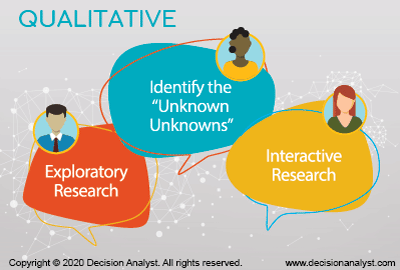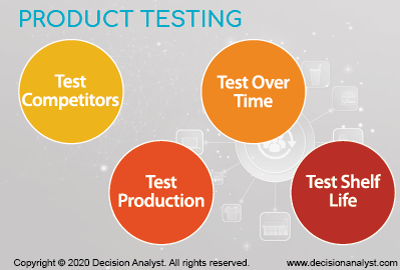Basic Research
By Jerry W. Thomas
Basic Research: Transcript
Hi, my name is Jerry Thomas, President and CEO of Decision Analyst, and I’d like to talk a little bit today about basic research, or basic marketing research. And, it really, it kind of seems strange to be talking in the modern world about basic research because we all think that we’re smarter than prior generations, and that we’re continuing to get more advanced and more sophisticated. But the sad truth is that in most large companies, the marketing research function, or the consumer insights function, has fewer people in the department, has a smaller budget relative to the size of the company than was true 50 or 60 years ago. So, there’s been tremendous reduction in spending on marketing research, and reductions in the size of those departments. So, I think it’s time that we start thinking about going back to basics.
And basic research, kind of the foundational elements of marketing research, I believe, begins with really good qualitative research. And so often in qualitative we’re doing it with some very narrow purpose, when its great advantage is to do exploratory, non-directive, open-ended research to help us understand what we know and what we don’t know. And this type of exploratory qualitative research that helps us learn, helps us identify the “unknown unknowns,” to quote Donald Rumsfeld, is a tremendous value in trying to manage a brand or a company.
-
 And we have so many different techniques we can use in qualitative, from projective to laddering to semiotics to observation and active listening, and we can learn so much. And with qualitative research, we can study problems or attack problems that have millions of variables. You can’t do that with any type of quantitative research, because the qualitative is completely interactive. You can turn it upside down, do it inside out, and you can do it all very quickly, and you can’t do that in quantitative analysis or research.
And we have so many different techniques we can use in qualitative, from projective to laddering to semiotics to observation and active listening, and we can learn so much. And with qualitative research, we can study problems or attack problems that have millions of variables. You can’t do that with any type of quantitative research, because the qualitative is completely interactive. You can turn it upside down, do it inside out, and you can do it all very quickly, and you can’t do that in quantitative analysis or research.
The next type of basic research that I think is really important is product testing. And everybody thinks their product is great and wonderful, and when we go out and test them, it’s true that your product is great about 20% of the time, and 80% of the time it’s not the best product, or not as good as clients think their products are. And I’m talking about doing in-home usage testing, or central location taste testing, or sensory research, or product clinics, or many different ways to test your products.
-
 But you want to test your products and your brand, and you want to test competitive products and competitive brands. And this is not something, it’s not one and done, you can’t just go out and do it and you’re finished, you’ve got to come back and do it 12 months from now. And you need to test your products coming out of Factory A versus Factory B; you need to test your products to find how long they’re viable on the shelf. So, product testing, in-home usage testing, product clinics are just fundamental to running a business and surviving long-term.
But you want to test your products and your brand, and you want to test competitive products and competitive brands. And this is not something, it’s not one and done, you can’t just go out and do it and you’re finished, you’ve got to come back and do it 12 months from now. And you need to test your products coming out of Factory A versus Factory B; you need to test your products to find how long they’re viable on the shelf. So, product testing, in-home usage testing, product clinics are just fundamental to running a business and surviving long-term.
Ad testing is another basic, foundational type of research that ought to be practiced and ongoing, and you want to test your advertising as well as the advertising of your major competitors. If you have a better product, and your advertising is more effective than your competitors, you’re a long way toward winning the competitive battle.
Another type of basic research is attitudinal and awareness tracking, or ad tracking, or brand tracking―whatever you want to call it―but a good tracking study. And you only need one; you don’t need an ad tracker, and a brand track―you can put it all in one study, and you don’t need to do it all the time. You can do it if your budgets are limited―do it once a year, but have a good foundational tracking program in place that you do on a regular basis, so that when something like COVID-19 comes along, you’ve got a tracking system in place so that you can measure what’s really changing and what’s happening.
One other type of basic research that I would like to mention before I close is choice modeling, and this really is a whole family of tradeoff, or conjoint-type techniques that can be used to optimize your pricing. The pricing differential can use to optimize profitability, packaging, positioning, communications, it’s a whole family of optimization techniques that can help you fine-tune and improve your marketing. And it doesn’t really―it’s not really basic in terms of being simple, but it’s basic in terms of being able to optimize so many aspects of marketing and do it in a very powerful way.
And basic research is really kind of―I mean these foundational studies that you’re doing on an ongoing basis, are like, are similar to wearing a life jacket when you’re out sailing in rough waters. Not very many people get drowned, if they’re wearing a life jacket, and so having an informational life jacket on helps companies survive the ups and downs of the business cycle. And not many companies go bankrupt if they’re doing a really good job with basic marketing research and staying in touch with their consumers and their target audience.
Contact Decision Analyst
Jerry W. Thomas (jthomas@decisionanalyst.com) is President/CEO of Decision Analyst. He may be reached at 1-817-640-6166.
Video Chapters
Below are the timestops for the research methods discussed:
- 01:22 Qualitative Research
- 03:06 Product Testing
- 04:33 Advertising Testing
- 05:07 Tracking Research
- 05:53 Choice Modeling


